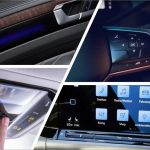New Frontiers in Automotive Interiors
‘Materials’ are no more just the commodities used in manufacturing a vehicle. As everything about a vehicle is getting ‘smarter’ materials are no exception. These advances in materials are contributing to enhancing the automotive interiors rapidly. If we compare interiors of an average car of today with the 3 decades old parallel, we will realise how far automobiles have come when it comes to in-cabin features and functionalities. Simple knobs, buttons and gauges have been replaced by dazzling dials and touch surfaces. Today’s car cabin is far better at communicating with its user to him or her feel safer, connected, and focused. Many auto experts feel that over the next 10 years, automobile interiors will change more than in the previous five decades.
With the increasing research happening on smart materials and on account of many usable innovations, the cars have started seeing application of smart surfaces go up. When it comes to smart surfaces, it’s actually a pathless land; there is so much happening, and the progress is in leaps and not linear.
What are the major drivers behind these advances in automotive interiors? If we take a closer look, many factors are dictating the use of smart surfaces/materials inside an automobile to achieve diverse outcomes. Some of them are:
Light weighting:
Light-weighting is one of the on-priority issues for OEMs manufacturing IC Engine vehicles as well as electric vehicles. For IC engine vehicle manufacturers light-weighting is crucial for keeping vehicle cost, transportation cost under the check as well as to provide higher mileage. For EVs, distance covered per charge is very critical. Light weighting a vehicle can significantly enhance range of an electric vehicle. Smart materials and technologies like IME (In-Mold Electronics) have a phenomenal role in simplifying and minimising number of components, complexity and thus reduce vehicle weight.
Regulatory Compliances:
Smart materials are helping OEMs to meet with increasingly stringent norms such as pollution control norms or safety features. Lightweighting plays crucial role in controlling emissions. As emission norms become strict, more and more OEMs would resort to smart materials to meet these norms. Safety features like ADAS, DMS etc. call for displays and screens which will also need use of smart interiors and materials.
Connected:
Globally, consumers are paying premium for connected features. We are already observing how car interiors are being reimagined keeping connectivity at the front of minds.
Safety:
Globally, regulators are getting more and more concerned about safety. Regulators are expected to mandate features that enable distraction free driving experience which will need features like displays, haptic response, cameras, gaze detection etc. inside the car. Along with that, use of voice commands, on screen alerts will also increase to provide more information to the driver without causing distraction. In the past, automotive interiors needed to be comfortable, attractive and smooth to the touch. Post pandemic, there is a new dimension: overall cleanliness and safety against viruses, pathogens and bacterias. Smart surfaces will play a key role in this aspect as well.
NVH:
In cabin experience is getting more and more consideration from OEMs as well as from consumers. Smart materials are already playing a phenomenal role in improving the cabin experience quality by dampening vibrations and cancelling noise.
Passenger comfort/Wellness:
With increasing level of autonomy in vehicles, OEMs and Tier-1s are already working on experience of passengers in the car. Immersive displays, gesture controls, on-demand entertainment, are some of the areas where smart interiors are being deployed thoughtfully.
Sustainable:
Consumers are shifting towards sustainable interiors and as this trend strengthens, we will see more sustainable technologies and materials being used in the car interiors.
Based on the above-mentioned trend drivers, following features are either already being used in cars or are expected to be used soon:
Existing Features:
Smart Interiors: When it comes to smart interiors, quite a lot is already being put to use. For instance, light emitting surfaces, displays that get activated only when you tap on them, touch buttons laid in door panels etc. are used today in top and mid end cars.
ADAS: Various ADAS features like Lane Departure Warning System, Parking Assistance System, Collision Warning Systems are implemented globally as standard features. Tier-1s have already developed cockpit models which have features required for the functioning of these systems.
Decoration: Use of stone, recycled materials, intelligent lighting is being smartly done by various manufacturers enhancing the decorative value of car interiors.
Features Expected to be Deployed in Near Future:
HMIs: While HMIs are already in use today, we expect them to become more intuitive. Multiple HMI features such as voice assistants, gesture controls, touch screens are present in the cars today, but their penetration and versatility are expected to increase manifolds in the near future.
Future ADAS requirements: The next level of ADAS will require many additional features in the car interiors. In full autonomous mode, the vehicle will have to have entertainment options not only for the passenger but also for the driver.
Cabin Monitoring: In-cabin monitoring is expected to be the next big thing in automotive interiors. DMC – driver monitoring cameras and OMC- occupant monitoring cameras are expected to be a common feature especially as we move towards shared mobility to ensure the safety of passengers.
Augmented reality: Augmented reality drastically increases the quantum of information that can be provided to driver as well as to the other passengers with least distraction. It also allows the driver and passengers to communicate to the vehicle seamlessly. As of now, very little has been done on this front, but we expect fast movement in the coming future.
What Companies are doing globally:
When we dug into the work being done by major auto interior players, here is what we found out:
Tactotek is working on using IMSE (injection molded structural electronics) to achieve multiple goals – lightweighting, thinning, reducing number of tools and assemblies required.
NextInput (now Qorvo) is now working to bring contextual awareness to the automotive cabin. For instance, if the road conditions become hazardous, the system will mute or soften the music and will suggest an alternate route.
Yanfeng Automotive Interiors demonstrated a concept autonomous interior which has four different modes – lounge, meeting, family and driving. The instrument panel is designed in such a way that even rear seat users can view it.
French global supplier Faurecia has developed morphing or adaptive instrument panel concept. In the drive mode, the panel functions as a normal informative screen. In autonomous mode, the display becomes larger and moves to the centre of the panel.
Mercedes has also unveiled its S-Class MBUX system each passenger, including the rear passengers can customise what they view on their respective screens.
Canatu : has co-developed The Origo Steering Wheel concept which aims to improve the way in which a driver accesses information, and controls non-driving functions, using thumb controls.
Grupo Antolin has developed a lighting system for decorative parts with integrated functions and capacitive switches converted into a smart surface.
Magna combines DMS with rearview mirrors which becomes an excellent system for in-cabin monitoring.
Indian Situation
India is the home to a large number of young and aspirational buyers. Over the past few years, Indian buyers have shown interest and willingness to pay a premium for features. OEMs introduced many features in India despite there being no regulatory push, purely to cater to consumers and win a larger market share by providing best in class features as a part of their marketing strategy. When it comes to introducing regulations, India is catching up fast. Regulations that get implemented in the European market are generally introduced in India with a lag of 2 years. All of this means that a huge opportunity exists for technology suppliers providing unique technologies relating the smart interiors in the Indian market. Quanzen is in touch with major tech centers and R&D teams of major OEMs and Tier-1s based in India. Please write to me at sudhir.nerurkar@quanzen.com to know more.




